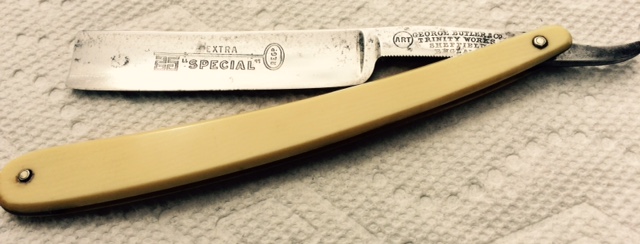Results 1 to 10 of 18
Thread: How to preserve blade etching
-
06-03-2016, 01:02 PM #1
 How to preserve blade etching
How to preserve blade etching
I am restoring a George Butler & Co razor. I am concerned about damaging the etching on the blade...and yet there is more discolouration and patina to remove. There's no rust or scaling...any advice? Will sanding with 600, 800, 1000, 2000 dig into the etch? Sorry for poor pic quality.

-
06-03-2016, 01:16 PM #2Senior Member


- Join Date
- Jun 2013
- Location
- Pompano Beach, FL
- Posts
- 4,049
Thanked: 636
Etching looks pretty strong. I would work slow and try to avoid most of the blade etch. You should be OK on the shank. Do hand sanding so you have more control of metal removal. Good luck.
-
06-03-2016, 01:21 PM #3I love Burls....... and Acrylic



- Join Date
- Mar 2012
- Location
- Baden, Ontario
- Posts
- 5,475
Thanked: 2284
If it were mine I'd get rid of any active rust and leave those beautiful age marks. Just me though.
Burls, Girls, and all things that Swirl....
-
06-03-2016, 01:33 PM #4Junior Member

- Join Date
- Nov 2015
- Posts
- 13
Thanked: 0
New to site how do I post a question or start a thread about razor restoration . Thanks Immy
-
06-03-2016, 02:12 PM #5Senior Member




- Join Date
- Feb 2013
- Location
- Haida Gwaii, British Columbia, Canada
- Posts
- 14,458
Thanked: 4830
That looks like a good candidate for steel wool and WD-40. Finish it with mothers polish and all should be well.
It's not what you know, it's who you take fishing!
-
06-03-2016, 02:52 PM #6Senior Member



- Join Date
- Apr 2012
- Location
- Diamond Bar, CA
- Posts
- 6,553
Thanked: 3215
Saving an etch is delicate work, yours looks pretty deep though.
Lapping film works exceptionally well. For the blade start with 1k or higher with a stiff backer. Small pieces of wet & dry or film and a pencil on the tip of the eraser works well to sand around the etch, take your time.
Micro Mesh sanding pads and paper work well for cleaning up around the etch when used carefully, but use lapping film over the etch for maximum performance.
I buy my film from Thor Labs, but you can buy single sheets from some woodworking and carving supplies. Diamond lapping film is 10 times the cost, but do not produce 10 times the performance, Silicone and Aluminum Oxides
Here is an excellent post by Geezer on darkening bluing and high grit sanding, (Revealing Etchings). The trick to cold bluing is scrupulously clean surface and a bit of heat from a hair dryer or heat gun.
-
The Following User Says Thank You to Euclid440 For This Useful Post:
Whizbang (06-03-2016)
-
06-03-2016, 03:26 PM #7Senior Member



- Join Date
- Apr 2012
- Location
- Diamond Bar, CA
- Posts
- 6,553
Thanked: 3215
000 and 0000 steel wool works well for clean up as said. Start with WD40 then dry the razor and use the steel wool dry, with liquid Chrome Oxide, Diamond Paste or Liquid or a good metal polish.
Take a couple of wooden stir stick glue them together with CA glue, to double the thickness and clip the end square with a pair of side cutters. Clipping a single stick works well for cleaning between the scales with steel wool or a WD40 soaked paper towel, I like the Blue Shop Towels for cleaning razors, buy them by the case at Sam’s and Costco.
Wrap the tip with steel wool to get into tight spots, the shoulders of stabilizers and the tang near the pivot pin.
The stamping on the tang are generally deeper and you can use Wet & Dry in place of film to clean and polish the tangs. Cold blue works great to make stamps pop.
-
-
06-03-2016, 08:23 PM #8
-
06-03-2016, 08:25 PM #9
-
06-03-2016, 11:17 PM #10

I've had great luck preserving etching by covering it with a thick layer of colored fingernail polish. The color makes it easy too see when you need to recoat during sanding". It comes pretty easy with polish remover once you're done sanding the blade.
"The production of to many usefull things results in too many useless people."
Karl Marx


 25Likes
25Likes LinkBack URL
LinkBack URL About LinkBacks
About LinkBacks






 Reply With Quote
Reply With Quote
